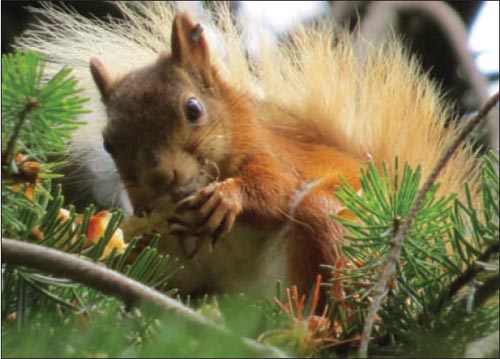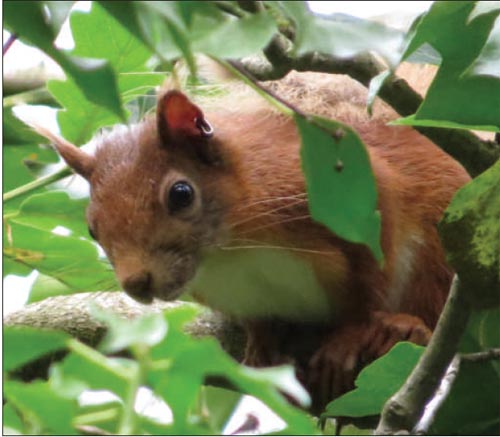| October
/ 2018 - Michael Ryan
|
| Many
years ago I was one of a group on a BirdWatch outing around Lehaunstown,
off the Brennanstown Road, not far from Cabinteely village. The group
was wandering up towards Tully’s Cross passing along a quiet
beechlined road then on to open fields. Lovely at any time it used
be a great spot for birds in the winter since a lot of the surrounding
area was then still working farmland and the cereal crops would attract
vast flocks of finches and including hundreds of Chaffinches, Goldfinches
and Linnets with every chance of much scarcer wintering Brambling
being among them. It was also one of the best places in south county
Dublin where there was a good chance of seeing a Yellowhammer. You
could walk over fields and along the abandoned railway line for an
hour and barely see a soul; it could have been in the middle of the
countryside. Further along the track as it approached Heronford Lane,
Long Eared Owls used to nest among the conifer plantation. Of course
now that abandoned Harcourt Street rail line we used wander along
is the busy LUAS line to Bride’s Glen and the cereal fields
it once cut through are going to soon become Ireland’s newest
town at Cherrywood. |
|
|
|
|
Jays are famous as mimics and a few weeks before,
around the same bit of woodland, we’d heard the very distinctive
call of a buzzard coming from the trees where we figured it must be
perched. We thought we had heard one anyway, until a
solitary jay flew out of the trees
but there was no buzzard to be seen and we suspected it was the jay
imitating it. Any doubts it had been the jay calling were dispelled
later when I had a search on YouTube and found, under the very specific
heading ‘(Eurasian) Jay mimicking a buzzard’, there was film of one doing a perfect imitation of a buzzard’s call. Of course there were loads more related videos including a very interesting video from Cambridge University about a study of captive jays and tests that were being conducted to prove their intelligence. The researcher had even taught one how to speak a few basic sentences. Another clip posted had the most extraordinary footage of a wild jay doing a perfect imitation of a cat meowing. Had the jay that was rattling it’s beak near the car park learned how to do it by imitating a hooded crow? It didn’t seem too much of a stretch for such a clever creature but in this case rather then imitating a call it would have been imitating an action, the clattering together of the bill’s mandibles. Then I watched another jay video, this one, evidently a pet, striding purposefully across a kitchen table but it was clattering its bill as it did so. So the jay we were watching may have known how to make the noise anyhow rather than copying it but it was still fascinating to see and hear it, always a privilege to witness animal behaviour you’ve never seen before. The small bright yellow spider we saw on a nettle leaf above the Vico Road was easy enough to identify as a crab spider, Thomisus Onustus, since they’re named because of the way they hold their front legs wide apart like crabs as they sit waiting for an insect to get close enough. They don’t make a web, instead relying on sitting immobile then erupting in a burst of speed to pounce on creatures like hover flies and bees, pray that is sometimes considerably bigger than they are. |
| |
||
Apparently
some species, over the course of ten days to 25 days, can actually change
colour to match the flower they’re perched on but the one we saw,
though small, being bright yellow stood out dramatically from its nettle
perch, looking like it was wearing the insect equivalent of a high visibility
jacket. Last month I wrote about our few very pleasant days spent in
Waterford during the summer. Any post holiday blues were happily dispelled
the day after our return by our first sighting in over two months of
red squirrels, three distinct individuals on both Dalkey and Killiney
Hills. The first one we saw, on our way down the path towards the car
park from the aircraft beacon, was a juvenile red with lush tufts of
hair growing from its ears and no metal ear clips, indicating it was
born this year and had not yet been trapped and recorded. It was feeding
on cones in a Douglas Fir tree as were the two reds we subsequently
sawover on Killiney Hill on our way up towards
the obelisk. By their metal ear clips we knew both were adults, one
with thin wisps of hair protruding from its ears, the other differentiated
by no ear tufts whatsoever. Grey squirrels have bare ears, an important
diagnostic to differentiate them from red squirrels but the adult reds
lose these tufts of hair for a short period in mid to late summer before
sprouting luxuriant new growth for the winter. There were a couple of walks organised on the Hill during Heritage Week titled ‘The Red Squirrel Trail Walks’. Unfortunately, although there was apparently a big turnout of people for the walks no red squirrels made an appearance! |
 |
|
Another
Red with bushy tail and no ear tufts on Killiney Hill Photo: Michael Ryan |
||
DALKEY HOME PAGE | DALKEY COMMUNITY COUNCIL | DALKEY HERITAGE COMPANY | CANNONAID




